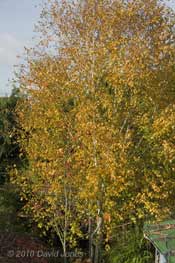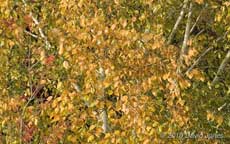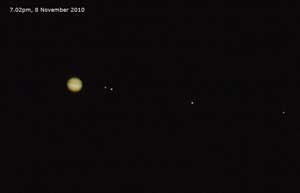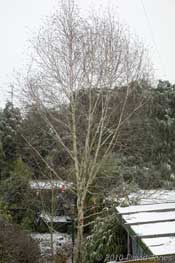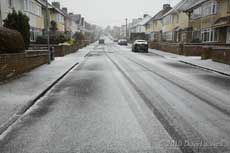Go to the last entry on this page .....Go to previous entry2 November - A period of mild weather has continued over the last week, and although there has been quite a bit of cloud cover we have had very little rain. The cloud has provided a degree of frustration as I have tried to continue with the photography of Jupiter, although I have managed to record it and its moons on most nights through gaps in the cover.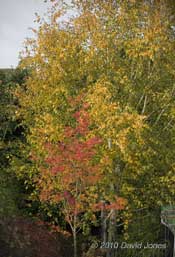 Six days ago I photographed the Rowan in all its Autumn glory. Then, the background was provided by a definitely green Birch tree. Over the last two days that has changed. This morning's hazy sunshine lit up an almost golden yellow tree. It seems to be a particularly good Autumn for colour, with numerous other trees along our road providing bright displays. However, it is likely to be a short display. A constant breeze is rapidly spreading the colours to the ground as the leaves fall away from branches.Down in the garden I have yet to continue with the work I started with such optimism the week before last. 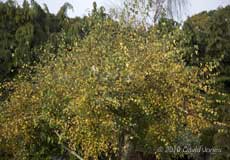
As usual, whenever I photograph our Himalayan Birch, I also recorded my neighbour's (well trimmed) native Birch, with its smaller leaves which are becoming a rather dull yellow - quite drab in comparison.
4 November - Two days later and the mild weather continues, and thanks to a south-wersterly air flow the temperature didn't drop below 14C last night, although it only rose some three degrees above that today under mainly cloudy skies.
Last night it was very windy, and by the time we looked out this morning the Rowan which had still been red yesterday had been stripped of all but a handful of its leaves. It is now inconspicuous against the brightness of the Birch tree.
That has turned a somewhat deeper, richer golden colour, with the branches in constant motion as the breeze continues. Look beyond the brightness of the canopy and you can see that the foliage within is still quite green. And the ground below is now starting to receive its carpet of fallen leaves.
As dusk fell, the clouds seemed to be more threatening, although the forecast suggests that it will be tomorrow morning before the present dry spell comes to its conclusion.
8 November - Autumn continues and the last couple of days have become somewhat colder again, and we have had some periods of heavy rain. This morning started wet but by the afternoon things had brightened up, and tonight I was able to see Jupiter quite clearly. I've continued with following the orbits of its moons, and I have now been able to photograph them for fifteen out of the last twenty nights. That mission will come to an end tomorrow night, weather permitting.
Tonight, all four moons are to one side of the planet, with the moons in the order Europa (nearest to Jupiter), Io, Ganymede and Callisto at the extreme right. I've assembled the pictures taken over the (nearly) three weeks into a slide show in an attempt to give some idea of how the moons move during their orbits. You can see this by clicking here (It is a pdf file of some 301Kb). In some of the pictures one or more of the moons are 'missing'. This is because they are hidden behind Jupiter. Unfortunately, I haven't had a chance to try and photograph the shadow of a moon that is passing in front of the planet. There will be a couple of opportunities to attempt this later in the month. For Io (orbital period 1.77 days) and Europa (orbital period 3.55 days) the sequence emphasises just how difficult it is to make sense of their motion on the basis of just one daily observation, with the missed days adding to the confusion. It is easier to 'see' the motion of Ganymede as it makes its way around its 7.15 day orbit, and even more so for Callisto, with its much longer orbital period of 16.69 days. To put the distances into some sort of perspective, Jupiter is has a diameter of about 143,000km; Callisto is about 1,883,000km from Jupiter; Ganymede 1,070,000km, Europa 671,000km and Io 422,000km. I'm not sure how far from Earth Jupiter is at the moment, but I understand that it is moving away from us at the moment, having made its closest approach to Earth for some 47 years when it was 594 million kilometres away on 20/21 September.
30 November - Another month with little recorded, but I
must end it with news of our first snowfall of the winter.
Needless to say, the feeders have all been busy, with at least a couple of
dozen House Sparrows, six or more Goldfinches, perhaps a similar number of
Blue Tits, and a couple of Great Tits. A bit of a surprise has been the
complete absence of Collared Doves and Wood Pigeons during the morning - the
first Dove not arriving until 1.40pm. Despite the bird bath being freed of
ice, cleaned and filled first thing I don't thing a single bird visited it
all morning (the ponds are frozen over).
One of the more frustrating features of my constant weariness is the difficulty I have in keeping going whenever I start another attempt at any serious photograph, hence the complete lack of any macro pictures for far too long. However, when I brought in some logs for the fire yesterday, a close look at one promising bit revealed the presence of perhaps in excess of a hundred barkfly eggs, along with healthy and at least moderately actice adults and nymphs. That log is now back out on my veranda and as soon as the force is a bit more with me I shall set things up for some photographs.
I have just bought (eBay of course) a large laboratory jack to which I
have made some additions to enable me to manouver objects more easily during
close-up photography. It's a bit of kit that I should have bought years ago
- thought about making my own many times, but never got beyond the planning
stage!
Click on images to see larger version
|
|
